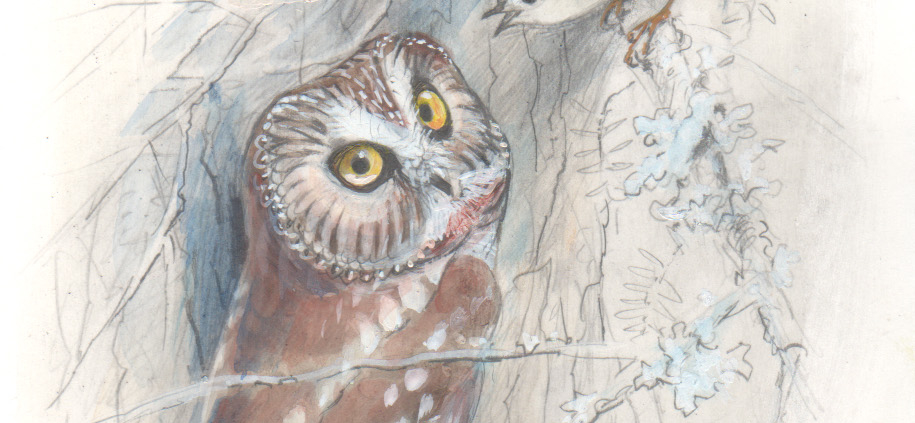Tracing The Travels Of Saw-Whet Owls
Story and illustration by Doug Pifer
The caravan of cars reached the top of South Mountain. A couple dozen riders emerged into the night, bundled into parkas and wearing winter coats. As we inhaled crisp November air, our ears were blasted with a continuous amplified recording that sounded like a big truck backing up.
We were members of the Potomac Valley Audubon Society (PVAS) at the South Mountain owl banding station near Boonesboro, Maryland. We hoped to witness the capture and banding of migrating saw-whet owls. The owl banding shed accommodates only a few people, so we gathered in front of the banding station, met station Coordinator Steve Huy and listened to his introduction.
During October and November, Huy and a few intrepid volunteers band saw-whet owls as they migrate from their breeding grounds in the Canadian forests to their wintering grounds in the eastern United States. For Steve Huy (pronounced like the slang word for U-turn) this is a labor of love. He’s become accustomed to sleepless fall weekends.
The smallest bird of prey in the eastern United States, a saw-whet weighs no more than a robin. The owl got its name from its nocturnal “song” that reminded early settlers of a whetstone sharpening a saw. To twenty-first century ears unfamiliar with saw sharpening, the analogy is lost. It sounds more like a backup alarm.
Banding migratory birds requires special licenses and training, under strict state and Federal regulations. Bird banding stations use mist nets, of mesh so thin it’s virtually invisible, to catch birds flying through the woods. In the 1960s, bird banders discovered that if they opened their nets at night, they sometimes caught many migrating saw-whet owls. Now 125 partnering bird banding stations participate in Project Owlnet, with funding from the Maryland DNR and many other agencies.
In 1966, when Wisconsin ornithologist Tom Erdman played a recording of a male saw-whet owl’s call, he captured eleven times more saw-whets than he had before. Project Owlnet banders now routinely broadcast recorded songs of the male saw-whet owl as an audio lure. Huy said barred and screech owls prey upon saw-whets, and sometimes get tangled in the nets. They too are banded and released “farther down the mountain.”
Once captured, an owl is removed carefully from the net and placed in a cloth bag. This minimizes stress on the bird during transport to the heated, well-lighted bird banding shed. There the owl is weighed, measured, and an aluminum band is gently slipped over its tarsus, the feathered part of the leg just above the toes. Leg bands identify place and date of capture. If a bird is already banded, data from the band is recorded.
Age and sex are determined by weight and feather condition. Males are generally one-third smaller than females. The owl is aged by shining an ultraviolet (UV) light on certain feathers. The fresh plumage of an owl then fluoresces bright raspberry red. The fluorescence comes from a coating of pigment called porphyrin, which breaks down over time. The overall fresh feathers of saw-whets less than a year-old glow brightly. The more worn feathers on older birds glow quantitatively less under UV light.
Then after a short interval to allow its eyes to readjust to darkness, the little owl is released into the night.
Why put a yellow-eyed bundle of feathers through the trauma of capture, banding and release? Project Owlnet, a dedicated group of trained biologists and private citizens, has been gathering fascinating data on banded saw-whets for the past 20 years. Recently, sophisticated nanotags and geolocators also enable bird students to track the wanderings of these owls. Saw-whets migrate erratically, and they’re far more numerous than was once believed. Over 90 percent of all captured owls are female, with only a few first-year males.
How many are there and are populations increasing or decreasing? Do adult males travel elsewhere or stay on their northern breeding territories? Like most research, the data leads to more questions. The more we learn about these wonderful owls, the better our ability to protect them in the future.
Illustration by Doug Pifer courtesy PA Game Commission. Photo credit: Photograph of saw whet owl at South Mountain by Tykee James, Governmental Affairs Coordinator, National Audubon Society.









